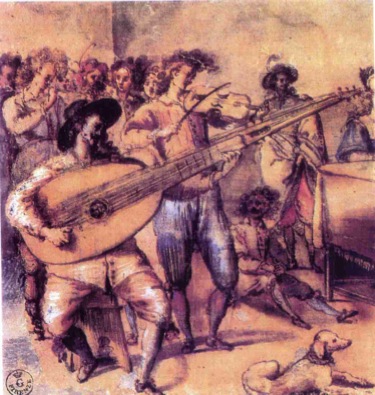A brief history of the theorbo

The Florentine humanists were ostensibly trying to recreate the ancient Greek art of recitation to an instrumental accompaniment. They turned initially to an instrument they knew - the lute - and modified it to suit their new needs. Starting with a bass lute, they restrung it at a much higher pitch, to gain a brighter, stronger sound. When its top strings broke under the strain, they simply replaced them with thicker strings tuned to the same note names but an octave lower. This resulted in one of the main characteristics of the theorbo, its peculiar tuning, which is called 're-entrant'. However, the theorbo retained the double strings of the lute, and almost all surviving theorbos are fitted for double strings on the fingerboard.

The tuning of the Italian theorbo
The theorbo was subsequently fitted with a long neck extension carrying additional bass strings, which were single. These are plucked with the right hand only, are tuned to a diatonic scale, and function like the bottom octave of a harp. The idea of adding long bass strings was used first on the lute, and several different styles of neck extension were used before the design used on the theorbo became common. Lutenist Alessandro Piccinini has left us a detailed description of the origins of the theorbo's re-entrant tuning, and the addition of long basses to the lute, in the preface to his 'Intavolatura di Liuto et di Chitarrone' (Bologna, 1623). The very large size of the theorbo, coupled with its very long neck, make it one of the most visually distinctive instruments ever made.

The theorbo's first repertory was the accompaniment of vocal monody, and we have exquisite works surviving by Caccini, Peri, and their contemporaries, which are best accompanied with theorbo alone. Such recitative-based vocal solos continued to be written throughout the 17th century, and the style was also carried over into the first operas, of which the best-known examples are Peri's 'Euridice' and Monteverdi's 'Orfeo'. The theorbo remained a fixture for opera accompaniment for decades. Many Italian operas of the mid-17th century are essentially continuo operas, and were performed with two keyboard instruments, two theorbos, and a pair of violins to supply instrumental ritornelli. Composers include Claudio Monteverdi, Francesco Cavalli, Luigi Rossi, Marco Marazzoli, etc.
There is also a large repertory of 17th century Italian instrumental music which calls for the theorbo as a melodic bass instrument, suppling elaborate bass parts in canzonas, sinfonias, sonatas and dances, by composers such as Cavalli, Marini, Neri, Ferro, Cazzati, etc. Much of this repertory was used during church services, and because the repertory often involved loud brass and stringed instruments, and was often performed in very large spaces, a new style of theorbo developed, which was probably designed especially for such occasions. These are huge instruments with single strings on the fingerboard, an unusual feature in the lute family, but one which enables a line to be played very strongly. Today the normal practice is to use single stringing on much smaller instruments, because single strings are easier to play, and enable one to play louder, but this was not the historical norm.
A small repertory of solo music was written for the theorbo, by a handful of virtuoso players. The most notable of these was Giovanni Girolamo Kapsberger, who published several books of solos as well as vocal and instrumental music with written-out theorbo parts in tablature. There is also solo music by Piccinini, Melli, Castaldi, and (later in the century) Pittoni and Viviani. There are also occasional obbligato parts for theorbo in operas and oratorios by Handel, Vivaldi, Conti, Hasse, etc. Vivaldi calls for four theorbos in the aria 'O servi volate' in his oratorio Juditha Triumphans.
The theorbo spread widely outside Italy, but it rarely remained unaltered. The French developed their own style of theorbo, which, unlike the often multi-ribbed, shallow-bodied Italian instruments, usually had a deeper broad-ribbed body, a single rose instead of the common Italian triple rose design, single fingerboard strings instead of double, and relatively shorter bass strings. Like the Italian instrument it usually had 14 courses, 6 stopped strings and 8 long basses, and was normally tuned in A with two re-entrant courses. It was widely used for continuo in French opera (e.g., Lully), to accompany chamber music (it is specified in prints by flautist Michel de la Barre, and viola da gamba player Marin Marais), and also for solo music. Some beautiful solo music survives by, for example, Robert de Visée, Hurel and Le Moyne, including arrangements of opera tunes, keyboard works, and vocal pieces. The French developed a smaller size of theorbo, called 'théorbe de pièces', specifically for playing solo music. This instrument had the same relative tuning as the large instrument in A, but was tuned a fourth higher, in D.
The English seem to have eschewed the Italian theorbo almost completely. A few instruments were certainly imported: there is a famous record of architect Inigo Jones attempting to bring one into England, and having it impounded by Customs officials at Dover. Theorbo-player Angelo Notari was in England for many years, and published a collection of monodies there in 1610; presumably he took his instrument with him. However, references to the theorbo in England are extremely rare, though the term 'theorbo' or 'theorbo lute' is very common, especially in Restoration songbooks. The preference was very much for smaller instruments retaining the renaissance lute tuning (or one of the French early baroque 'accords nouveaux'), though with up to twelve courses of double strings. The double-headed lute, invented by Jacques Gaultier, was extremely popular in England, and evidently fulfilled the accompanimental role. Occasional references to the archlute are also found from the 1660s, becoming commoner after c.1700.


